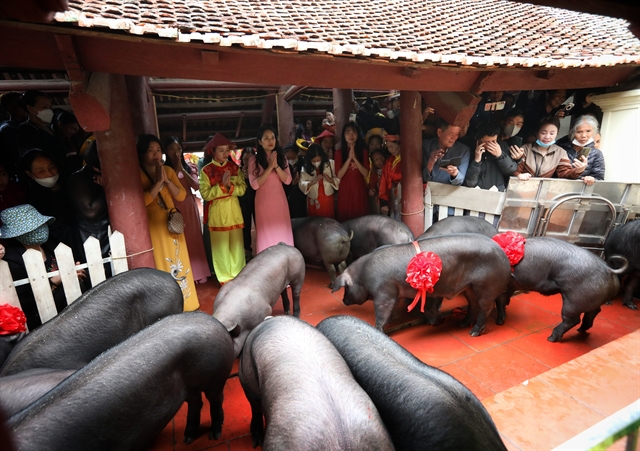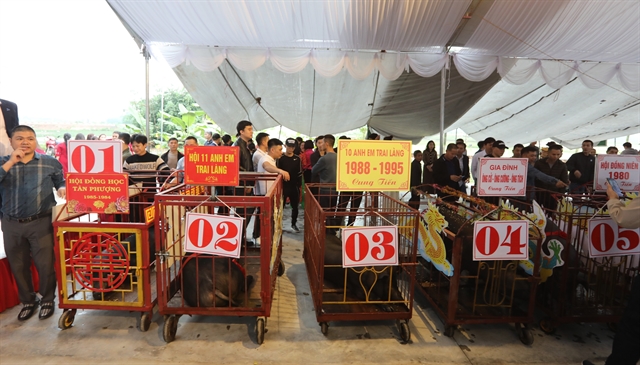
The procession of black pig offering ceremony. VNA/VNS Photo
BẮC GIANG - Since early morning, 19 of the most beautiful black pigs in Tân Phượng Hamlet, Tân Mỹ Commune in the northern province of Bắc Giang were bathed with ginger water and adorned with red silk ribbons to participate in a special local ritual taking place in the hamlet.
The black pig offering ceremony, also called ông Lang ceremony, was held on March 20. It is held to commemorate those who have made contributions to the village and to pray for favourable weather conditions and prosperity. It is a unique tradition that has been preserved until today, showcasing the Vietnamese tradition of remembering and honouring one's roots.
According to local elderly, the deity worshipped in the shrine of the hamlet is Hoàng Phó Lang, a high-ranking mandarin during the Lê Dynasty (1428-1789). He was born and raised in the ancient village of Phụng Pháp, which is now Tân Phượng Hamlet.
During his lifetime, he was known for his extensive knowledge and academic achievements, having achieved top scores in three imperial examinations. He made significant contributions to the local community, such as reclaiming land, taking care of agricultural activities, and improving the living conditions of the locals.
To commemorate his contributions, the villagers established a shrine to worship him and held the black pig offering ceremony on the 11th and 12th days of the second lunar month. During this ceremony, offerings, including black pigs, are presented as a gesture of gratitude and respect to the deity.
Pork used to be considered a valuable food source, with black pork being even more rare and precious, in the village in the past when the local economy was difficult. Therefore, as a gesture of gratitude and respect, the villagers chose black pigs as offerings for the ceremony.
The black pig offering ceremony experienced a decline during the wars, but it has been revived and preserved by the local people since the 1990s.

The pigs selected for the ceremony are black in colour, still alive, clean, glossy, and well-fed. VNA/VNS Photo
The number of offerings varies each year, depending on the conditions and preferences of families and the local community. The pigs selected for the ceremony are black in colour, still alive, clean, glossy, and well-fed.
This year, local families offered 19 black pigs, which were called ông Lang. After being cleansed with ginger water and adorned with red ribbons, they were placed in red-painted iron cages and displayed at the village's cultural house. They were then inspected, certified and numbered by an organising committee.
Afterward, when the good hour arrived, the master of the ceremony signified the start of the procession. The sound of drums filled the air as the procession began. The drum troupe and flag bearers led the way, followed by the robust men carrying ông Lang. The procession was joined by a diverse group of people all dressed neatly and beautifully.

The ceremony is held to commemorate those who have made contributions to the village and to pray for favourable weather conditions and prosperity. VNA/VNS Photo
This is the fifth year villagers Hoàng Văn Cử, Hoàng Văn Cường, and Hoàng Văn Tích’s families offered pigs for the ceremony. Hoàng Văn Thanh, a member of one of the families, said his family used to raise the pigs themselves for the offering, but they had to buy one this year.
Two months before the ceremony, they travelled to the northern province of Hà Giang to carefully select a beautiful black pig. Every week, the pig was bathed with ginger water and rice wine for cleansing.
Meanwhile, this was the first time that Hoàng Văn Lợi's family donated a black pig for the ceremony. It was a male pig, raised for over a year and weighing about 130kg.
“We have been successful in our business and our ancestors blessed us with good luck this year, so we have decided to offer a pig as hope for a fortunate and favourable life,” he said.
After the ông Lang were brought into the shrine, they were taken out of cages and placed in front of an altar for the ceremony. The families offering pigs then stood in front of the incense table to perform the ritual ceremony. During the ceremony, an elderly village resident acted as the presiding official and recited the ceremonial prayers, expressing gratitude for the significant contributions of the late Hoàng Phó Lang and seeking his protection and blessings for the village, wishing for peace, good health, favourable weather, and prosperity in business.
After the ceremony was completed, the black pigs were returned to their respective families to be used as offerings for feasts, inviting children, relatives, and extended family members. A portion of the offering was also reserved for the villagers and visitors to enjoy during the communal gathering at the shrine on March 21.
There were also cultural and entertainment activities held, like the duck-catching game, which attracted a large number of participants.
According to Hoàng Minh Khanh, the head of the village and the organiser of the ceremony, the black pig ceremony has been cherished by Tân Phượng villagers as a distinctive cultural tradition.
“Through this ceremony, the Vietnamese tradition of paying homage to our roots and ancestral origins is manifested. It is also an occasion for villagers to report on the achievements of the past year and pray for a new year filled with favourable weather, harmony, good fortune, and prosperity,” he said. VNS
OVietnam